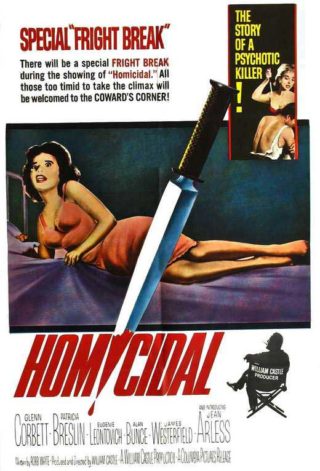 One of the more interesting films made by William Castle, who could always be counted on for unique and enjoyable entertainment. That’s the case in this agreeably twisted psychodrama, the CRYING GAME of its time.
One of the more interesting films made by William Castle, who could always be counted on for unique and enjoyable entertainment. That’s the case in this agreeably twisted psychodrama, the CRYING GAME of its time.
William Castle, one of Hollywood’s premiere showmen, made several worthy horror films during the fifties and sixties. He was known primarily for elaborate in-theater gimmicks, which Castle took to a level unprecedented then or now. A popular Castle gimmick was the “Punishment Poll” in Mr. SARDONICUS (1961), in which the film was stopped before the end and the audience polled as to what they’d like to see happen to the title character. For his masterpiece THE TINGLER (1959) Castle actually had theater seats wired to buzz people’s shoulders at the point in the film where the titular critters, which nestle in people’s spines and cause a tingling sensation, get loose.
The gimmick of the PSYCHO-inspired HOMICIDAL (1961) was equally novel: it had a “Fright Break” before the climax, with an onscreen clock (retained in the DVD version) counting down the minutes until the movie resumed, allowing audience members too scared to sit through the rest of the picture a chance to leave—but only by walking down a yellow path and standing in a “Coward’s Corner” for the rest of the crowd to jeer at. Such showmanship worked, as HOMICIDAL was one of Castle’s more successful productions; it helped, of course, that it’s also one of his all-around best films.
Emily, an attractive blond woman, rents a hotel room and strikes up a conversation with a bellboy. At the end of the convo Emily makes a bizarre request: she asks the bellboy to marry her and then get the marriage annulled the next day (and offering him two thousand dollars in the bargain). He agrees, and they head to the home of a justice of the peace to get hitched—but before the ceremony is done Emily takes a butcher knife from her purse and stabs the justice to death…and then takes off.
Emily heads to a house in the small California town of Solvang, where, it turns out, she takes care of the elderly Helga, a wheelchair-bound stroke victim. Emily is secretly married to Warren, who grew up with Helga as his guardian. Warren’s half-sister Miriam also lives nearby, and harbors unsavory suspicions about Emily and Warren.
Miriam’s qualms seem to be confirmed by two police inspectors who begin sniffing around the area. It seems Emily used Miriam’s name on her marriage certificate, yet the would-be groom, who was left holding the justice of the peace’s murdered corpse, doesn’t recognize Miriam.
Suspicion for the killing rightfully falls on Emily. She decides to sever her family ties, first by offing Helga. Warren and Miriam race to the family house to save Helga—Warren enters first and is inside for a long time, so Miriam decides to go in after him. It’s here that the Fright Break occurs…but then the film resumes, and we’re made privy to a shocking secret.
William Castle is probably destined to be remembered more for his showmanship than his directorial skills, but he was a skilled moviemaker who in HOMICIDAL turned out a taught and nasty suspensor. Clearly the film owes more than a little something to PSYCHO—in its twisty narrative, creepy oedipal undercurrents, outrageous twist ending and final psychoanalysis to sum everything up—but it has a perverse aura that sets it apart. It’s ultimately more a twisted family drama than the psycho thriller it was sold as, with above-average performances and a dark sense of humor. That said, the scary stuff is pulled off with a great deal of flair, particularly in the ultra-intense climax, which is topped off by an ahead-of-its-time bit of grotesquerie and one of the finest, most audacious reveals of any horror movie ever.
About that final reveal, it’s sadly no longer the shocker it once was. Matter of fact, I’d be surprised if there’s anyone out there today who can’t figure out the film’s “secret.” I won’t give it away here, but will say that the androgynous appearance of the character of Warren aroused suspicion with me, as did the fact that he and his homicidal wife are never seen together. It must be said that actress Joan Marshall (under the nom de plume Jean Arless) delivers a remarkable dual performance in which she convincingly portrays both an alluring blond murderess and…somebody else.
Vital Statistics
HOMICIDAL
Columbia Pictures
Director: William Castle
Producer: William Castle
Screenplay: Robb White
Cinematography: Burnett Guffey
Editing: Edwin Bryant
Cast: “Jean Arless” (Joan Marshall), Glenn Corbett, Patricia Breslin, Eugenie Leontovich, Alan Bunce, Richard Rust, James Westerfield, Gilbert Green
